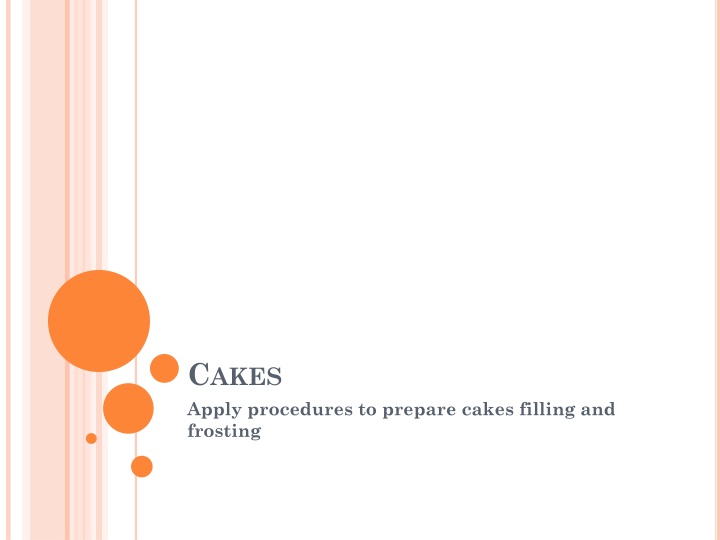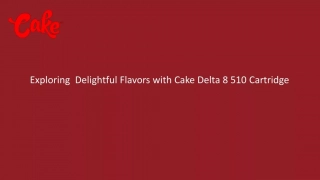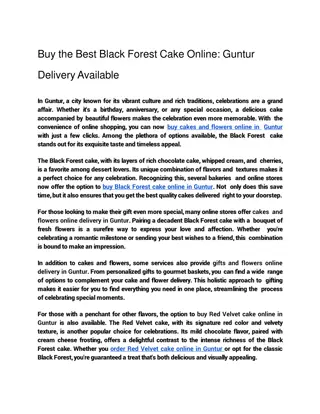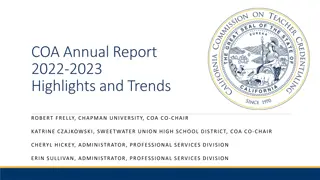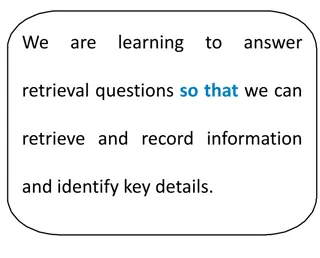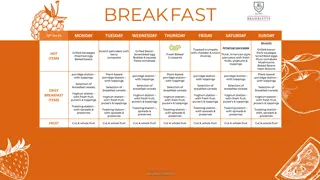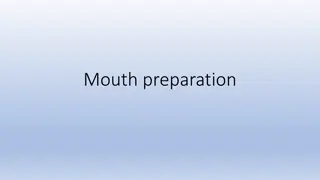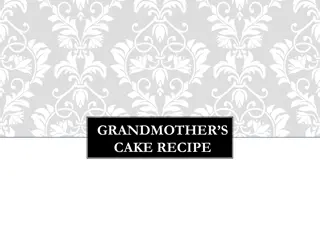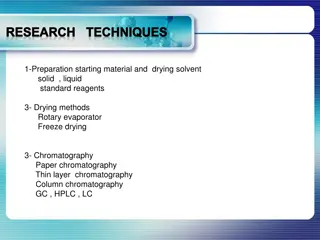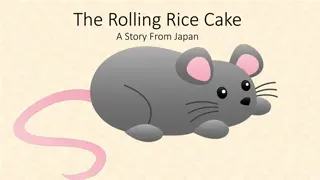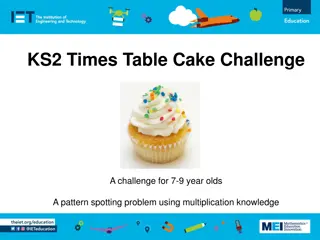Mastering Cake Preparation Techniques
Learn the essential procedures for preparing cakes, including filling and frosting. Explore different types of cakes, such as shortened, unshortened, chiffon, and more. Understand the importance of proper panning, scaling batter, mixing techniques, and the creaming method. Enhance your cake-making skills with valuable insights and step-by-step instructions.
Download Presentation

Please find below an Image/Link to download the presentation.
The content on the website is provided AS IS for your information and personal use only. It may not be sold, licensed, or shared on other websites without obtaining consent from the author.If you encounter any issues during the download, it is possible that the publisher has removed the file from their server.
You are allowed to download the files provided on this website for personal or commercial use, subject to the condition that they are used lawfully. All files are the property of their respective owners.
The content on the website is provided AS IS for your information and personal use only. It may not be sold, licensed, or shared on other websites without obtaining consent from the author.
E N D
Presentation Transcript
CAKES Apply procedures to prepare cakes filling and frosting
CAKES TYPES 1. Shortened a types of fat that helps create a smooth consistency throughout the mixture . 2. Unshortened- contain a large proportion of foamed eggs and/ or egg whites to lesser proportion of sugar. Angel food, Sponge, genoise ( made with lots of stiffly beaten eggs whites , which makes them light and airy) 3. Chiffon- They are made by using whipped egg whites, or meringue , to lighten a mixture
PREPARATION Panning: -Pans should be filled to 2/3 full so that the batter does not spill over the side of the pan as it rises. -Pans should be prepared before the batter mixed and filled soon after so air cell in the batter do not collapse. - For all but foam cake , tap the filled pans firmly on a bench or counter to let large air bubble escape before baking
SCALING BATTER Based on the amount of liquid in the batter and the amount of handling a batter can withstand. - Creaming Method- These thick batter do not pour easily . ( 1stPlace a prepared cake pan on the left side of the scale , 2ndbalance the scale to zero, 3rdset the scale for the desired weight, 4th add batter to the prepared pan until the scale balances.) - .
SCALING CAKE Blending Method- They have more liquid than creaming method which can be measure by volume. ( 1stplace an empty volume measure on the left side of the scale, 2ndbalance the scale to zero, 3rdset the desired weight and pour the batter into the volume measure until the scale balances, 4thpour the batter into the prepared pan, being careful to scrape out all of the batter from the volume measure). Sponge or Foam Method- To keep beaten eggs from collapsing these batter, handle the batter as little as possible
MIXING A properly mixed cake has the desired texture and grain. Air is blended into the batter and all ingredients are mixed completely. Each method produces a certain kind of cake. Five Standard Methods : Creaming Method Blending Method Sponge or Foam Method Angel Food Method Chiffon Method
CREAMING METHOD To begin with all ingredients at room temperature and accurately scaled . Following Steps: Cream the butter or all- purpose shortening sugar and salt. Cream the mixture on medium speed for about 4-6 minutes, until it is lighter in volume, texture, and color. Add the eggs and other liquids gradually in small amount. Beat the mixture on low speed. Add the sifted, dry ingredients and mix on low speed to incorporate the dry ingredients with the next ingredients 1. 2. 3.
BLENDING METHOD This method produces a smooth batter that makes, tight and firm-grained cake: Blend the sifted flour, sugar, chemical leavened and others dry ingredients for 30 seconds on medium speed. Add the shortening and half of the liquid Mix on low speed until the ingredients are moistened Increase the speed to medium and mix for 5 minutes Scrape the side of the bowl and add the remaining liquid Blend on low speed for 3 minutes. 1. 2. 3. 4. 5. 6.
SPONGE OR FOAM METHOD Leavening is formed from air that is trapped in the beaten egg. All ingredients are at room temperature melt the butter and set it aside Heat sugar and egg in double boiler, stirring constantly to about 110 F Beat the eggs high speed for 10- 15 minutes Sift all the dry ingredient the carefully fold them into the foam. Fold in melted batter, but do not overmix Pan and batter at once so it doesn t lose volume. 1. 2. 3. 4. 5. 6.
ANGEL FOOD METHOD Have no fat and are based on egg-white foam. Contain large amount of sugar. Gradually add the sugar as you whip the egg whites 1.Whip the egg whites with half the sugar, salt, and cream of tartar to full volume 2. Sift the remaining half of the sugar with the flour
CHIFFON METHOD Closely related to angle food Steps Whip the egg yolks and half of the sugar to full volume. They will be light pale yellow Fold in sifted flour and other dry ingredients Whip the egg white and remaining half of the sugar. 1. 2. 3.
FILLING AND FROSTINGS Frostings are sweet coatings for cakes and other baked goods Icings ( frostings) 3 MAIN Functions They improve the keeping qualities of the cake by forming a protective coating around it They contribute flavor and richness They improve appearance. 1. 2. 3.
TYPES OF FROSTINGS Cooked frosting- buttercreams, caramel icing, glaze, Grenache , gum paste, fondant , molding chocolate. Uncooked Frosting Fillings raspberries, peaches, cream cheese , strawberries.
CAKE DECORATING ACCESSORIES Writing Tip- Used for letters, numbers, stems dots and outlines Petal Tip- Used to make flower petals, ribbons and bows Leaf Tip- Used to make leaves, delicate petals and borders Star tip- Used to make rosettes and fancy boarders Flower Nail- Used as a base upon which rose are built with the petal tip Decorator s Tube and Coupler- Tube hold the frosting
STORING AND SERVING CAKES -Cakes should be wrapped in air-tight containers or plastic wrap stored in refrigerator until needed. -If cakes is wrapped properly and not decorated it can be kept up to one month - - Frosted cake should be boxed or covered so they don t absorb to refrigerator odors. - Bring to room temperature before serving - - Sheet cakes keep fresh and moist longer than layer cakes -
